Method for selective extraction of cannabinoids from a plant source
a plant source and selective extraction technology, applied in the field of selective extraction of cannabinoids, can solve the problems of low extraction yield, reduced purity and safety of the resulting extract, and difficult removal of solvent traces from the end produ
- Summary
- Abstract
- Description
- Claims
- Application Information
AI Technical Summary
Benefits of technology
Problems solved by technology
Method used
Image
Examples
Embodiment Construction
[0144]Effect of Plant Pre-Heating
[0145]As explained hereinabove, at least a portion of the CBD is found in the plant in the form of CBDA. Decarboxylation of CBDA can be carried out by heating the plant at controlled conditions to obtain the desired CBD. The plants used in the following examples were various hybrids of Cannabis sativa and Cannabis indica.
[0146]For evaluating the effect of heating the plant source prior to the extraction process on the extraction yield, the content of cannabinoid species in various strains of dried cannabis plants were profiled prior to heating by HPLC.
[0147]Plant samples (a mixture of flowers, leaves and stems was used) were roughly chopped and heated in air atmosphere at a temperature of between 90 and 170° C. for between 10 and 120 minutes. The samples were then extracted with ethanol (10 ml per 100 mg of plant) for 30 minutes under stirring at 30-35° C. Ethanol was used as a solvent for a reference to the conversion of CBDA to CBD, as determined ...
PUM
| Property | Measurement | Unit |
|---|---|---|
| wt % | aaaaa | aaaaa |
| temperature | aaaaa | aaaaa |
| pressure | aaaaa | aaaaa |
Abstract
Description
Claims
Application Information
 Login to View More
Login to View More - R&D
- Intellectual Property
- Life Sciences
- Materials
- Tech Scout
- Unparalleled Data Quality
- Higher Quality Content
- 60% Fewer Hallucinations
Browse by: Latest US Patents, China's latest patents, Technical Efficacy Thesaurus, Application Domain, Technology Topic, Popular Technical Reports.
© 2025 PatSnap. All rights reserved.Legal|Privacy policy|Modern Slavery Act Transparency Statement|Sitemap|About US| Contact US: help@patsnap.com



